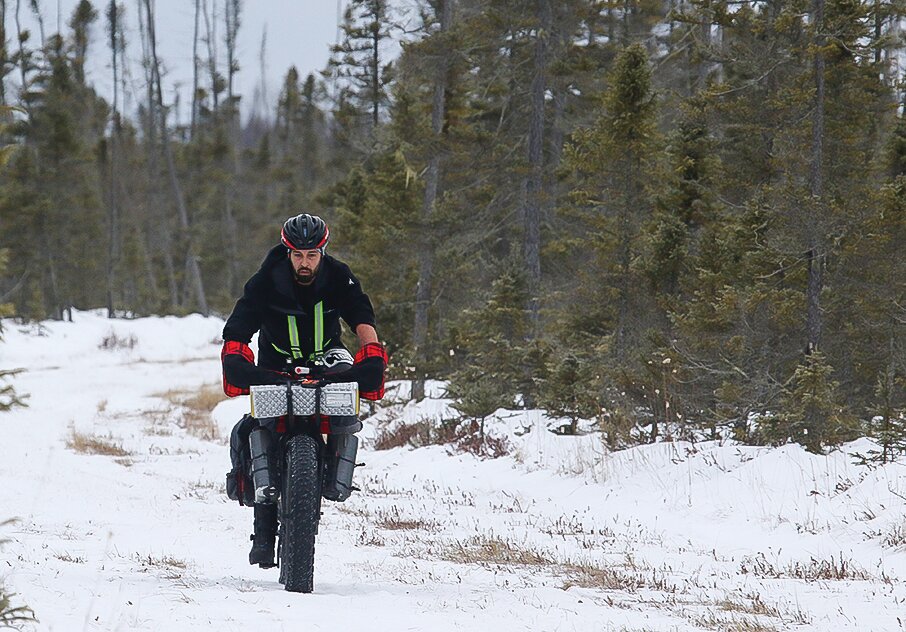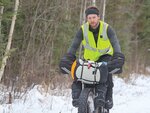Support the Timberjay by making a donation.
Warmth creates its own challenges for racers
Soft snow, open water, and a rough trail contribute to slowest times in years for ultramarathoners
REGIONAL— Frostbite. Frozen water bottles. Those are typically the biggest challenges that participants in the Arrowhead 135 ultramarathon face along the winding course between International …
This item is available in full to subscribers.
Attention subscribers
To continue reading, you will need to either log in to your subscriber account, or purchase a new subscription.
If you are a current print subscriber, you can set up a free website account and connect your subscription to it by clicking here.
If you are a digital subscriber with an active, online-only subscription then you already have an account here. Just reset your password if you've not yet logged in to your account on this new site.
Otherwise, click here to view your options for subscribing.
Please log in to continue |
Warmth creates its own challenges for racers
Soft snow, open water, and a rough trail contribute to slowest times in years for ultramarathoners
REGIONAL— Frostbite. Frozen water bottles. Those are typically the biggest challenges that participants in the Arrowhead 135 ultramarathon face along the winding course between International Falls and Tower. Set in what is normally the coldest week of winter in the North Country, the race is famous for regularly offering up some of the coldest race temperatures in North America.
But the 155 racers who left the starting line early Monday morning may remember 2024 as the year they faced some of the toughest conditions of all, thanks to a record warm winter that proved to be a bigger challenge than the cold.
The warm weather and the minimal snowfall so far this winter had left much of the marathon’s usual route nearly impassable at times. The vast majority of the route, which follows the Arrowhead snowmobile trail, had never been groomed this winter due to the lack of snow. That grooming, combined with more typical snowfall, tends to smooth out the trail, flatten the brush and other vegetation that grows up each year, particularly in the vast swamps traversed by the trail. In cold weather, those groomed trails set up hard and can make an excellent base for the fat tire bikers who make up the vast majority of the participants in the race.
Not this year. Instead, racers fought shoulder-high brush, swampy hummocks, and soft snow that led many to multiple wipe-outs along the way. “The worst was between the second and third checkpoints,” recalls Mike Running, of Ely, who competed in the Arrowhead for the first time and finished 14th. Running and other racers reported about a seven mile stretch of the trail that apparently had not seen a snowmobile all winter. That left untracked snow, peppered with brush and other vegetation that forced the racers to walk with their bikes for two or three hours.
“We were post-holing the whole way,” said George Hollerbach, of Newtown, Pa., who completed his fourth Arrowhead 135 on Tuesday, at his slowest time ever, at about 26 hours.
It wasn’t just Hollerbach who was lagging. Race co-organizer Jackie Krueger, of International Falls, said racers were having their slowest race in many years. The first-place finisher, Nick Nygaard, of Duluth, reached the final checkpoint at Fortune Bay Tuesday morning, a little over 24 hours from the Monday morning start in the Falls. That was about eight hours slower than the typical winning pace, said Krueger. It was Nygaard’s first attempt at the Arrowhead 135, so his first-place showing was impressive nonetheless. He said he would have liked to have seen smoother trails, but acknowledged this year’s unusual conditions were part of the experience. “Part of the ethos of the race is to deal with whatever is handed to you and make the most of it—I was ok with how it turned out.”
Hollerbach said the warm temperatures made the snow much softer than usual and that made it difficult to keep their bikes in a straight line. Racers ran into trouble, particularly on downhills, where many reported spills. Andy Weinzierl, of Duluth, said he wore a helmet for the first time out of concern over potential injuries. He said he experienced several falls due to the soft snow, which would catch front tires, sending them off in unexpected directions.
Equally unexpected was the open water on at least one of the river crossings, which prompted race organizers to provide heavy-duty garbage bags to all the racers, which they used like make-shift hip waders to get through the water. “We’d never had to deal with open water before,” said Krueger.
While many of the racers appreciate the solitude along the trail, Krueger said they had more than usual this year because they sharply limited their usual snowmobile patrols due to the poor trail conditions. She said they would have responded had a racer gotten into trouble, but the usual checks just weren’t feasible this year.
As tough as the bikers had it, a few other racers had it worse. One competitor, who was traveling the route by kick sled, languished for long stretches through swampy hummocks that tipped her sled almost continuously and dense brush that blocked her path.
Kreuger said there’s only one thing that keeps racers moving forward under such difficult circumstances. “Pure stubbornness,” she said. “It comes to that attitude of ‘I’m just not quitting.’” There is, of course, a time limit in play. The racers have a total of 60 hours to travel the 135 miles, but few manage to hold out for 60 hours given the limited opportunities for sleep.
Several racers were lounging and fueling up in the board room at Fortune Bay on Tuesday morning, winding down from the event and comparing notes on their experiences on the trail. Some were headed off for the next race. Hollerbach, a retired cardiac nurse, was scheduled to fly to Alaska later in the week to bike the Iditarod trail, a competition he’s entered before. Running, from Ely, was heading home and back to normal life. While some of the racers are constantly training in rugged conditions, Running took a bit more laid-back approach. He said he likes to bike the new trails at Hidden Valley and did some training with a loaded bike and had a stationary bike at his home which he used to help build endurance.
Most of those hanging out were waiting for friends, partners, or others they’ve met over the years from the rather exclusive world of extreme ultramarathoners.
It’s a world that Kreuger says she’s come to see as family. Her husband Ken has done the Arrowhead and other ultramarathons before, but she says she’s content to handle the logistics. “Im not a glutton for punishment,” she said. “But I like to hear the stories.”
Brian K. Anderson contributed reporting for this story.









